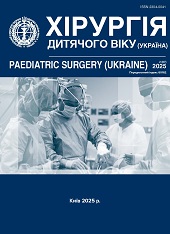Spleen volume as a non-invasive predictor of complicated portal hypertension: clinical significance and diagnostic potential
DOI:
https://doi.org/10.15574/PS.2025.2(87).4451Keywords:
splenomegaly, portal hypertension, prediction, gastroesophageal varices, spleen volume, non-invasive diagnosticsAbstract
Portal hypertension (PH) is a common complication of liver cirrhosis, leading to the development of esophageal and gastric varices (GOV), ascites, and hypersplenism. One of the most prevalent manifestations of complicated portal hypertension (CPH) is splenomegaly (SMG), observed in 80-90% of patients. Spleen volume (SV) is considered an integrated marker of splanchnic hemodynamics and a potential predictor of the severity of PH.
Aim - to investigate the prevalence of SMG in patients with diagnosed CPH and to evaluate its predictive value for the presence of GOV.
Materials and methods. A total of 187 patients with acquired chronic liver disease (ACLD) (fibrosis or cirrhosis) and clinically significant portal hypertension (CSPH) with confirmed grade II-III GOV were included, along with 46 healthy controls (CG). SV was measured by ultrasound B-mode by determining three linear dimensions and using automated calculation. The Child-Pugh score was used to assess liver functional status. For evaluating the prediction model parameters of GOV, ROC analysis with calculation of AUC was applied.
Results. SMG (SV >314 cm3) was detected in 98% of patients with GOV and in none of the CG. The mean SV in the study group was 5.8 times higher than in CG (853.3±404.3 vs.146±56.9 cm3), with median values of 765 cm3 and 140 cm3, respectively (p<0.0001). The area under the ROC curve (AUC) for SV as a predictor of GOV was 0.995, with a sensitivity of 98.9% and specificity of 100% at the cut-off point of 293 cm3.
Conclusions. The high prognostic value of SV as an independent predictor of the presence of GOV in patients with ACLD and CPH has been confirmed. No association between SV and the degree of the liver dysfunction was established.
The study was conducted in accordance with the principles of the Declaration of Helsinki. The study protocol was approved by the Local Ethics Committee for all participants. Informed consent was obtained from patients.
The authors declare no conflict of interest.
References
Alnajjar A, Al-Hussaini H, Al Sebayel M, Al-Kattan W, Elsiesy H. (2015). Liver transplantation for Budd-Chiari syndrome with large solitary focal nodular hyperplasia of the liver in a patient with essential thrombocytemia: Case report. Transplantation Proceedings. 47(7): 2282-2286. https://doi.org/10.1016/j.transproceed.2015.05.008; PMid:26361700
Aubrey-Bassler FK, Sowers N. (2012). 613 cases of splenic rupture without risk factors or previously diagnosed disease: A systematic review. BMC Emergency Medicine. 12: 11. https://doi.org/10.1186/1471-227X-12-11; PMid:22889306 PMCid:PMC3532171
Badran DH, Kalbouneh HM, Al-Hadidi MT, Shatarat AT, Tarawneh ES et al. (2015). Ultrasonographic assessment of splenic volume and its correlation with body parameters in a Jordanian population. Saudi Medical Journal. 36(8): 967-972. https://doi.org/10.15537/smj.2015.8.11809; PMid:26219448 PMCid:PMC4549594
Berzigotti A. (2017). Non-invasive evaluation of portal hypertension using ultrasound elastography. Journal of Hepatology. 67(2): 399-411. https://doi.org/10.1016/j.jhep.2017.02.003; PMid:28223101
Caglar V, Alkoc OA, Uygur R, Serdaroglu O, Ozen OA. (2014). Determination of normal splenic volume in relation to age, gender and body habitus: A stereological study on computed tomography. Folia Morphologica. 73(3): 331-338. https://doi.org/10.5603/FM.2014.0038; PMid:25465038
De Franchis R, Bosch J, Garcia-Tsao G, Reiberger T, Ripoll C et al. (2022, Apr). Baveno VII - Renewing consensus in portal hypertension. J Hepatol. 76(4): 959-974. Epub 2021 Dec 30. doi: 10.1016/j.jhep.2021.12.022. Erratum in: J Hepatol. 2022 Jul; 77(1): 271. https://doi.org/10.1016/j.jhep.2022.03.024; PMid:35431106
Ghany MG, Morgan TR; AASLD-IDSA Hepatitis C Guidance Panel. (2020, Feb). Hepatitis C Guidance 2019 Update: American Association for the Study of Liver Diseases-Infectious Diseases Society of America Recommendations for Testing, Managing, and Treating Hepatitis C Virus Infection. Hepatology. 71(2): 686-721. https://doi.org/10.1002/hep.31060; PMid:31816111 PMCid:PMC9710295
Hidaka H, Nakazawa T, Wang G, Kokubu S, Minamino T, Takada J et al. (2010). Reliability and validity of splenic volume measurement by 3-D ultrasound. Hepatology Research. 40(10): 979-988. https://doi.org/10.1111/j.1872-034X.2010.00705.x; PMid:20887333
Juncu S, Minea H, Girleanu I, Huiban L, Muzica C, Chiriac S et al. (2024). Clinical Implications and Management of Spontaneous Portosystemic Shunts in Liver Cirrhosis. Diagnostics. 14(13): 1372. https://doi.org/10.3390/diagnostics14131372; PMid:39001262 PMCid:PMC11241716
Kanda Y. (2013). Investigation of the freely available easy-to-use software 'EZR' for medical statistics. Bone Marrow Transplant. 48: 452-458. https://doi.org/10.1038/bmt.2012.244; PMid:23208313 PMCid:PMC3590441
Kaneko J, Sugawara Y, Matsui Y, Ohkubo T, Makuuchi M. (2002). Normal splenic volume in adults by computed tomography. Hepato-Gastroenterology. 49(48): 1726-1727. PMID: 12397778.
Prassopoulos P, Daskalogiannaki M, Raissaki M, Gourtsoyiannis N, Hatsidakis A. (1997). Determination of normal splenic volume on computed tomography in relation to age, gender and body habitus. European Radiology. 7(2): 246-248. https://doi.org/10.1007/s003300050145; PMid:9038125
Ripoll C, Groszmann R, Garcia-Tsao G, Grace N, Burroughs A, Planas R et al. (2007). Hepatic venous pressure gradient predicts clinical decompensation in patients with compensated cirrhosis. Gastroenterology. 133(2): 481-488. https://doi.org/10.1053/j.gastro.2007.05.024; PMid:17681169
Yetter EM, Acosta KB, Olson MC, Blundell K. (2003). Estimating splenic volume: Sonographic measurements correlated with helical CT determination. AJR. American Journal of Roentgenology. 181(6): 1615-1620. https://doi.org/10.2214/ajr.181.6.1811615; PMid:14627584
Downloads
Published
Issue
Section
License
Copyright (c) 2025 Paediatric Surgery (Ukraine)

This work is licensed under a Creative Commons Attribution-NonCommercial 4.0 International License.
The policy of the Journal “PAEDIATRIC SURGERY. UKRAINE” is compatible with the vast majority of funders' of open access and self-archiving policies. The journal provides immediate open access route being convinced that everyone – not only scientists - can benefit from research results, and publishes articles exclusively under open access distribution, with a Creative Commons Attribution-Noncommercial 4.0 international license(СС BY-NC).
Authors transfer the copyright to the Journal “PAEDIATRIC SURGERY.UKRAINE” when the manuscript is accepted for publication. Authors declare that this manuscript has not been published nor is under simultaneous consideration for publication elsewhere. After publication, the articles become freely available on-line to the public.
Readers have the right to use, distribute, and reproduce articles in any medium, provided the articles and the journal are properly cited.
The use of published materials for commercial purposes is strongly prohibited.

